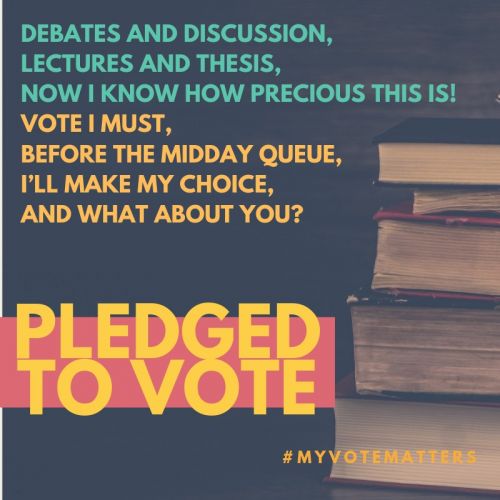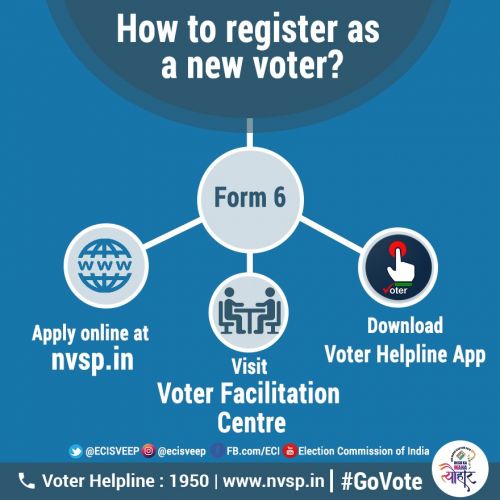
A majority of educators will agree that students grasp the most when learning meets fun. The ELC learning tools have been developed in a manner such that important information, which might seem banal in textbooks, is imparted in engaging ways to young students. The following are a description of six activities out of a total of 30 that have been developed for the ELCs:
1. Nirvachitra
A portmanteau of the words Nirvachan and Chalchitra, Nirvachitra introduces the electoral process and procedures through an engaging film show or a picture story scroll developed by the ECI. Nirvachitra is the first activity proposed for all ELCs to set the tone of the club.
Set in the environment of Class XII students in a school from a rural area, the film Masti, Dosti aur Matdaan, covers the basics of voter registration by introducing concepts like democracy and value of a vote as well as talking about the age of eligibility, how to register as a voter, the documents required, etc., through its animated characters. For schools where screening the film is not possible, story scrolls have been developed that send out the same message with their characters Abha and Abhay.
Before the film screening, the convener (teacher) shall have an introductory discussion with the students where their knowledge and views on democracy, voting, etc., are gauged. Post the film/scroll show, students are prompted to recall their first memories of an actual election held in their vicinity irrespective of their parents/guardians/relatives/neighbours' participation and make a poster either on the most important takeaway of the film or on the importance of elections and voting.
2. Card Game
Drawing inspiration from the popular card game UNO, two card games Vigilant Voter and Be the People’s Representative have been developed. Each deck consists of six cards in five colours along with some lucky and unlucky cards to make the game interesting. Each of the six numbered cards carry messages specific to the respective games. The player who arranges all the six cards in their correct order in a single chosen colour and reads out the messages stated on the cards correctly, wins the game.
The Vigilant Voter enables the players to play through the perspective of a voter. The six cards break down the entire registration and voting process, right from eligibility till poll day, into six key messages. The Be a People’s Representative game lets the players don the role of a contesting candidate and breaks down the candidate’s journey in an election to six messages in six cards. The idea of the card games is that while playing, the students absorb the messages communicated while still enjoying a good game.
3. Build your Ballot
An activity developed specifically for the students of class IX, Build your Ballot is aimed at familiarizing the students with EVM (Electronic Voting Machine) and VVPAT (Voter Verifiable Paper Audit Trail). Through this activity students will make their own ballot paper with dummy candidates and symbols including NOTA.
The game requires 15 students as volunteering candidates of a hypothetical election. The aim is for the entire class to make their own ballot paper. For this purpose a chart paper is used to make the layout of a dummy ballot paper. Fifteen pre-decided symbols denoting state parties, national parties, registered parties and individual candidates are shuffled and randomly allotted one each to every student acting as a candidate.
Following this, the candidates come forward and alphabetically arrange their names on the ballot paper according to actual ECI guidelines. First, the students with state and national party symbols come forward to form category I and write their names alphabetically on the ballot, and stick/draw their symbols against their name. Category II is formed by registered party candidates. Last but not the least, individual candidates arrange their names on the ballot.
The idea behind building the ballot is for the voters to realize that candidates are arranged on the ballot in an unbiased manner according to set guidelines, and give an idea on where to find the name of the candidate of choice on the ballot.
4. Hopscotch – Matdaan ke Padav
Matdaan ke Padav or Steps to Vote, is a stapu (hopscotch) game designed to familiarize students with the steps of voting. The game is printed on a flex and laid on the ground for students to play. It consists of 10 steps with each step carrying a question.
The player has to hop and stand on one foot throughout the game and will lose if the other foot touches the ground. The player enters the game by standing at the start position and throws a coin inside the first rectangle which is the first step of the game. S/he then reads out the question written inside the rectangle loudly for all to hear and answers it in either “Yes” or “No”. Similarly, the player progresses by throwing the coin in the next rectangle and repeating the process until they reach the tenth and the last rectangle.

The game creates awareness amongst players by asking questions like “Should we check our names in the voters’ list before elections?”, “Before entering the polling station should we keep our identity proof and voters’ slip ready?”, “On the EVM, do we have to press a button in front of the name of a candidate we have chosen?”
5. NOTA
NOTA stands for None of the Above. If a voter does not wish to vote for any political representative, s/he can still exercise their franchise by voting for NOTA. The activity, for students of class X, introduces the concept of NOTA to the students in a humorous way and sends out the message that knowing what you do not want is as important as knowing what you want.
This activity uses colourful, visual flashcards. Each flashcard poses a question and offers four answers to the question. The first three options are deliberately funny, silly and incorrect. For example, if the question is, “Which one of the following is a means of transport?” The first three options to this question are a water bottle, a hen and a carpet. The fourth option to every question is NOTA. Thus students choose NOTA as the answer to every question, familiarizing them with the concept in the process.

However, post the flashcard display, the convener brings out one final round where the following question is verbally asked - “Who do you vote for?”
The answers would include:
-
A corrupt politician bribing people to vote in his/her favour.
-
A lazy politician who is inefficient.
-
A politician with criminal charges.
-
None of the Above (NOTA).
The Convener then initiates a group discussion or debate in the class on the topic of NOTA.
The ELC Resource Guides developed individually for class IX, X, XI and XII detail the activities to be conducted with the respective classes in one academic year. Each activity includes an element of summary and recall at the end. Each grade will only spend about four hours on ELC activities in a year, and yet the long-term impact of the club activities will be significant in creating prepared, responsible and informed young voters of India. These aware and educated voters of tomorrow will also be the ones who will act as ambassadors of democracy who will share their knowledge, inform and educate their peers, their family and their community at large.
Edited by Apoorv Tiwary

















.jpeg.83142042611ae65249594cdd9f05f158.jpeg)







Recommended Comments
There are no comments to display.